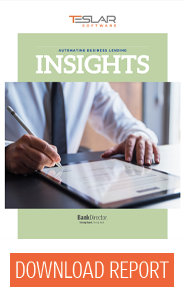
Insights Report: Automating Business Lending
Brought to you by Teslar Software

KEY TAKEAWAYS
- A period of slow loan growth could present an opportunity for community
 banks to automate the business lending process.
banks to automate the business lending process. - Commercial and industrial lending slipped in the first half of 2023, with bankers reporting weakened demand from firms of all sizes.
- Automation frees up time and resources, allowing bankers to focus on client relationships.
- When upgrading lending processes, banks should plan to run systems in tandem and work out kinks in the new system.
- Banks can choose to automate all or some of the lending process, based on their unique needs.
The spring of 2020 wasn’t the best time for a community bank like Bank of Idaho to automate its small business lending process.
The $1 billion bank, a subsidiary of Bank of Idaho Holding Co., had just made it through the first deluge of Paycheck Protection Program loans. “We did everything manually, and it was terrible,” says Devan Wright, deputy chief credit officer. He describes “12-hour days that felt like forever: waking up, approving loans, going to bed, over and over again. We did thousands of loans.”
Executives quickly realized they needed to upgrade the bank’s underwriting and loan processing systems to survive the second round of PPP, working with Teslar Software to automate parts of Bank of Idaho’s loan underwriting and documentation functions.
When the dust settled, Wright says, the Idaho Falls-based bank automated the rest of the business lending process with Teslar. For example, it pulled into one platform all of the 20 or so forms that could be needed if a loan required a modification after it was booked, eliminating the need for a banker to go hunting for the correct form.
With lending appetite down drastically today compared to the PPP period, Bank of Idaho’s experience could make a compelling case for automating the business lending process during the slow growth period many bankers find themselves in now.
Lending Slowdown
Commercial and industrial lending slumped this year amid an uncertain economic environment, characterized by rising interest rates, low unemployment and anxiety about a potential recession. As of June 1, the Federal Reserve Bank of St. Louis reported that C&I lending across U.S. banks totaled $2.8 trillion — still higher than pre-pandemic volume but representing a slight but steady decline from early 2023. That figure exceeded $3 trillion in May 2020, when Bank of Idaho and others were fielding intense demand due to PPP.
Additionally, the Federal Reserve’s Senior Loan Officer Survey in July 2023 found weakened demand for C&I loans from small, medium and large firms. Many banks also indicated that underwriting standards had tightened somewhat as the economic outlook grew more uncertain and competition for loans had eased.
Reduced activity could provide an opportunity for community banks to automate part or all of their business lending systems, if they haven’t already. Banks that choose to streamline underwriting or loan modification systems now are unlikely to be pressured by intense demands on time and resources while adapting to a new system, says Amy Berger, vice president of product at Teslar Software.
“Loan production might not be off the charts right now,” she says, but bankers can still use those updated systems to manage portfolios and loan renewals until loan demand accelerates.
“I would say this is the best time to do it. The time we did it [during PPP] was the worst,” Wright says. “When times are slow, it’s the best time to implement change. Testing is easier. Running systems in tandem, which takes twice as much work, is easier. This is the perfect time to really hit a home run.”
Balancing People and Process
Bank of Idaho is not alone in the way it went about updating its business lending process. Anthony Edwards, senior credit risk officer at Skyline National Bank, shares a similar experience. The subsidiary of $1 billion Skyline Bankshares in Independence, Virginia, also automated certain aspects of its lending process after the first round of PPP financing.
In-person meetings with clients are still an important part of Skyline’s business model, so executives chose not to automate the entire process. “We still have a traditional banking model when it comes to the customer experience of applying for and closing the loan,” he says. Instead, the bank focused on streamlining backroom operations, such as building loan packages, tracking documentation and creating digital workflows, Edwards says.
Automating those parts of the process has freed up bankers’ time and mental energy. Staff no longer need to spend copious amounts of time scanning documents, working in shared files or Excel.
“[Teslar] creates a large degree of efficiency with its handling of those small tasks,” Edwards says. “We have incredibly smart people, and we take some of those rudimentary tasks out of the picture so they can focus on what they’re good at.”
Bank of Idaho had a similar experience. Wright estimates that automating the lending process through Teslar saved the bank the equivalent of two additional full-time employees. The bank hasn’t let go of any lending staff because the bank’s loan volume, along with its asset size, has more than doubled since the first quarter 2020.
But it hasn’t needed to add any more back office staff to keep pace with increased loan production, he says.
Bankers looking at automating their lending process frequently worry about potential layoffs, Berger says. But that’s seldom what actually happens. It’s more constructive for bankers to think in terms of how their staff might be able to repurpose their time once the more mundane tasks of lending are streamlined.
“If it’s a better experience for your banker, trust me: It’s a better experience for your client,” she says.
To download the report, sponsored by Teslar Software, click here.
The Automating Business Lending Insights report was originally published in the 4th quarter 2023 issue of Bank Director magazine.

